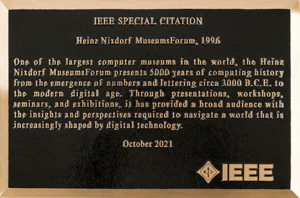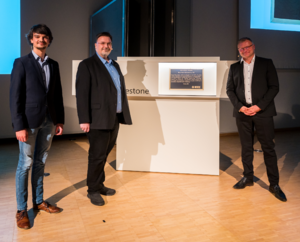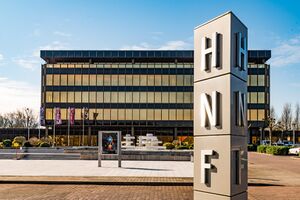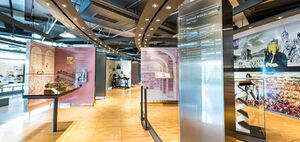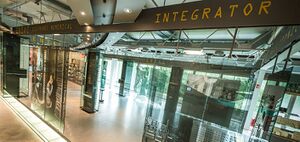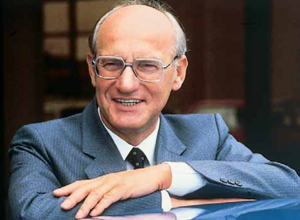Milestones:Special Citation Heinz Nixdorf Museum, 1996
Title
Heinz Nixdorf MuseumsForum, 1996
Citation
One of the largest computer museums in the world, the Heinz Nixdorf MuseumsForum presents 5000 years of computing history from the emergence of numbers and lettering circa 3000 B.C.E. to the modern digital age. Through presentations, workshops, seminars, and exhibitions, it has provided a broad audience with the insights and perspectives required to navigate a world that is increasingly shaped by digital technology.
Street address(es) and GPS coordinates of the Milestone Plaque Sites
Heinz Nixdorf MuseumsForum, Fürstenallee 7, D-33102 Paderborn, Germany, (GPS: - 51.731558, 8.736558)
Details of the physical location of the plaque
On the wall in the interior foyer, a public area which can be entered free of charge.
How the plaque site is protected/secured
The building is secure at all hours.
Historical significance of the work
The Heinz Nixdorf MuseumsForum (HNF) is one of the largest computer museums in the world. Every year over 100.000 visitors come to Paderborn to learn about the history of computers in the permanent exhibition that spans 6.000 m² (around 65.000 ft²) and contains 2.500 objects.
The museum is located in a building that has a historic significance itself: The former headquarter of the “Nixdorf Computer AG” (NCAG), which once was one of the largest computer companies in Europe. The initial collection was donated by Heinz Nixdorf, who was convinced that computers were a tool for mankind to build a better future. He therefore envisioned the museum as a place for a broad public to learn about the history of this technology.
In addition to the permanent exhibition, the museum also has a complete floor for special exhibitions that focus on different topics like “Hello Universe! The experience of space travel” (2020), “Digging Deep - Hidden treasures from the museum’s warehouse” (2018), “IT began with Ada. Women in computer history” (2015), “Codes and Clowns. Claude Shannon - Juggler of science” (2009 – 2010), “Computer.Sport” (2009), “Computer.Medicine” (2006 - 2007) or “Computer.brain” (2001 – 2002).
The actual exhibition is only one of the many ways that the museum teaches its visitors about computers. It is called “MuseumsForum” because the building also has 7 seminar rooms and a large auditorium (386 seats) in which a wide variety of events and conferences take place. The museum is supposed to be a place where people learn and discuss historic and contemporary technologies, their potentials and risks for society. From the opening of the museum in 1996 until the end of 2020 the museum hosted 20.980 events in total. For children and pupils, the museum offers a wide range of courses and regularly hosts science competitions.
Apart from the educational aspect, the mission of the museum is also to retrieve and preserve the knowledge of how historic computers worked and how they were used. To this end, the museum follows a strategy that combines a large archive (300 m², 3200 ft²), a library with 14.000 books, reconstruction projects and the collection of oral histories.
In the community there is an ongoing discussion to what extent old computers should be kept operational or whether they should be sealed away for preservation. The HNF tries to balance the different aspects of conservation and takes an active part in the discussion with partners worldwide. For the reconstruction of an ENIAC accumulator panel the museum won the 2016 Tony Sale Award. It is currently working on a functional replica of Claude Shannon's mouse in a maze machine (“Thesus”) and a tube based replica of Heinz Nixdorf’s first electronic accumulator (“Elektronensaldierer”).
Features that set this work apart from similar achievements
The museum in its size and broad engagement in computer history is a unique place that attracts visitors and historians from around the world. It does not only focus on the exhibition of historic artifacts, but plays an active role as it organized two international conferences on history of computing in 1998 and 2000:
- http://hsozkult.geschichte.hu-berlin.de/termine/paderbo.htm
- Hashagen, Ulf; Keil-Slawik, Reinhard; Norberg, Arthur L. (Eds.): History of Computing: Software Issues. Berlin, Heidelberg, New York: Springer 2002
The museum is also in close contact with other museums in Germany and worldwide and has fruitful collaborations and exchanges of ideas. One example of such a collaboration are the “Cypher Events” that were conducted between the HNF and the british National Museum of Computing (TNMoC) in Bletchley Park. During the first event in 2007, a secret message was encrypted using an original Lorenz SZ42 machine from WWII and sent from Paderborn to Bletchley Park using Morse code. There, the encrypted message was fed to the Colossus rebuild which then cracked the code. This event was repeated 10 years later, but this time the message was encrypted using an Enigma and decrypted using the Turing-Welchman Bombe (https://www.youtube.com/watch?v=fPWrf2TQdE8).
Significant references
- Facts and figures about the museum:
- List of previous special exhibitions:
- Tony Sale Award:
- Article about the museum’s approach to conservation and education:
- J. Blobel and J. Viehoff, “The New Public Engagement in Computer Museums and in the History of Computing Machines”, Proc. Making IT Work, p. 81-90, May 2017, https://www.computerconservationsociety.org/miw/Proc%20MIW%202017.pdf
- Virtual tour through the museum:
Supporting materials
Dedication Ceremony
Map
